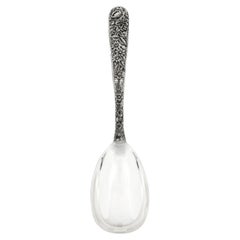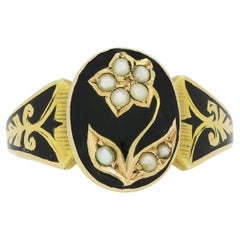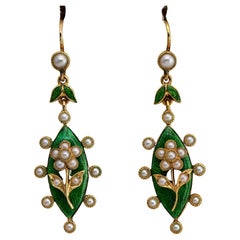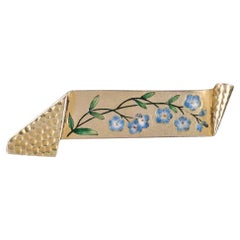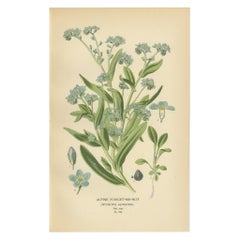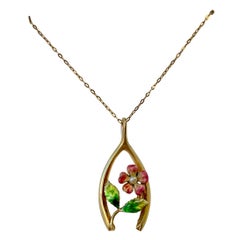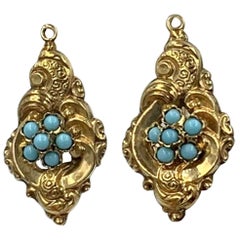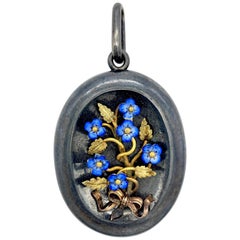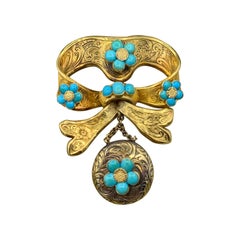Antique Forget Me Not
1910s American Antique Forget Me Not
Sterling Silver
19th Century Victorian Antique Forget Me Not
Pearl, Gold, Yellow Gold, Enamel
Mid-19th Century European Antique Forget Me Not
Natural Pearl, 18k Gold, Enamel
Early 20th Century Edwardian Antique Forget Me Not
14k Gold, Enamel
1890s English Antique Forget Me Not
Paper
19th Century Unknown Victorian Antique Forget Me Not
Pearl, Gold, Yellow Gold, Enamel, 10k Gold
19th Century Unknown Victorian Antique Forget Me Not
Turquoise, Gold, 10k Gold, Yellow Gold
1840s British Early Victorian Antique Forget Me Not
Enamel, Stainless Steel, Gilt Metal
19th Century Unknown Victorian Antique Forget Me Not
Turquoise, Gold, Yellow Gold, 14k Gold
19th Century French Belle Époque Antique Forget Me Not
Gilt Metal
19th Century French Napoleon III Antique Forget Me Not
Bronze
19th Century Unknown Belle Époque Antique Forget Me Not
Emerald, Pearl, Gold, 14k Gold, Enamel, Yellow Gold
1790s European Georgian Antique Forget Me Not
Diamond, 18k Gold
1880s Victorian Antique Forget Me Not
Pearl, Turquoise, Gold, 14k Gold, Rose Gold
1870s Victorian Antique Forget Me Not
Gold, 18k Gold, Yellow Gold, Enamel
19th Century Aesthetic Movement Antique Forget Me Not
18k Gold, Yellow Gold, Enamel
19th Century Unknown Victorian Antique Forget Me Not
Diamond, Gold, 14k Gold, Yellow Gold, Enamel
19th Century Unknown Art Nouveau Antique Forget Me Not
Diamond, Gold, 14k Gold, Yellow Gold, Enamel
Early 1900s Art Nouveau Antique Forget Me Not
Gold, 14k Gold, Yellow Gold, Enamel
19th Century British Victorian Antique Forget Me Not
Pearl, Turquoise, 15k Gold, Yellow Gold
19th Century Italian Victorian Antique Forget Me Not
Multi-gemstone, Turquoise, Gold, 14k Gold, Yellow Gold
19th Century Unknown Victorian Antique Forget Me Not
Diamond, 14k Gold, Enamel, Gold, Yellow Gold
1850s Australian Victorian Antique Forget Me Not
18k Gold
1910s Bajan Folk Art Antique Forget Me Not
Shell, Mahogany
Early 20th Century European Edwardian Antique Forget Me Not
Pearl, Gold, 14k Gold, Yellow Gold, Enamel
19th Century British Victorian Antique Forget Me Not
9k Gold, Yellow Gold
Late 19th Century Victorian Antique Forget Me Not
Agate, 15k Gold, Yellow Gold
1850s English Victorian Antique Forget Me Not
Silver, Enamel
Early 20th Century English Edwardian Antique Forget Me Not
Pearl, Turquoise, Gold, 9k Gold, Rose Gold
19th Century Italian Modern Antique Forget Me Not
Stone, Metal
Late 19th Century British Victorian Antique Forget Me Not
Pearl, 15k Gold, Enamel, Gold
1920s Art Deco Antique Forget Me Not
Marcasite
1840s British George III Antique Forget Me Not
Onyx, 18k Gold
1880s Austrian Antique Forget Me Not
Pearl, Silver, Enamel
Early 1900s Unknown Edwardian Antique Forget Me Not
Marcasite
Early 20th Century German Antique Forget Me Not
Ormolu
19th Century Unknown Art Nouveau Antique Forget Me Not
Pearl, Gold, 14k Gold, Yellow Gold, Enamel
1820s French Regency Antique Forget Me Not
18k Gold, Enamel
1750s British George II Antique Forget Me Not
Porcelain
Early 19th Century French Restauration Antique Forget Me Not
Opaline Glass
Late 19th Century Antique Forget Me Not
Oil
Early 1900s German Art Nouveau Antique Forget Me Not
Ceramic
Late 19th Century Victorian Antique Forget Me Not
Porcelain
Early 19th Century English Regency Antique Forget Me Not
Porcelain
Early 19th Century French Restauration Antique Forget Me Not
Opaline Glass
19th Century Italian Victorian Antique Forget Me Not
Multi-gemstone, Onyx, Gold, Yellow Gold, 10k Gold
Early 19th Century American Georgian Antique Forget Me Not
Agate, Moonstone, Turquoise, Gold Plate, Pinchbeck
1820s French Charles X Antique Forget Me Not
Opaline Glass
Mid-19th Century Italian Victorian Antique Forget Me Not
18k Gold, Yellow Gold
Early 20th Century German Mid-Century Modern Antique Forget Me Not
Brass
19th Century British Regency Antique Forget Me Not
Gold, Yellow Gold
Early 19th Century Antique Forget Me Not
Oil
Early 19th Century French Restauration Antique Forget Me Not
Opaline Glass
Early 19th Century French Restauration Antique Forget Me Not
Opaline Glass
Early 19th Century French Restauration Antique Forget Me Not
Opaline Glass
19th Century Unknown Art Nouveau Antique Forget Me Not
Diamond, Ruby, Sapphire, Gold, 14k Gold, Enamel
Late 19th Century Italian Antique Forget Me Not
Ormolu
1880s Victorian Antique Forget Me Not
Pearl, Turquoise, Gold, 18k Gold
- 1
Antique Forget Me Not For Sale on 1stDibs
How Much is a Antique Forget Me Not?
- What is an antique settle?2 Answers1stDibs ExpertApril 5, 2022Mainly built around the 17th century, antique settles are a type of long bench with a high back and open arms. Settles were made of wood and were fairly simple in construction. You can shop a collection of antique settles from some of the world’s top sellers on 1stDibs.1stDibs ExpertApril 5, 2022A settle is a type of large bench, usually with arms and a high back. Popular in England, settles are typically designed to fit three or four people. Many examples from the 17th century survive today. On 1stDibs, shop a collection of antique and modern settle benches from some of the world’s top sellers.
- What is an antique fob?1 Answer1stDibs ExpertApril 5, 2022A fob is a pendant that can be attached to a chain. Common types of fobs would be a pocket watch, a piece of jewelry or a locket. On 1stDibs, you can find antique fobs from some of the top sellers around the world.
- What is an antique coffer?1 Answer1stDibs ExpertApril 5, 2022An antique coffer is one of the oldest pieces of furniture. It is a box or chest that’s simple in design, constructed with solid oak planks and a hinged lid. Shop a collection of antique coffers from some of the world’s top sellers on 1stDibs.
- What is antique pewter?2 Answers1stDibs ExpertApril 5, 2022First used by the Egyptians and later the Romans, pewter is an alloy composed predominantly of tin. It can also be mixed with copper, silver or lead. Shop a collection of expertly vetted antique pewter pieces from some of the world’s top sellers on 1stDibs.1stDibs ExpertApril 5, 2022Pewter is a type of tin alloy that’s been popular for centuries. Many examples of antique pewter objects exist, including dinnerware and sculpture. On 1stDibs, you’ll find a collection of antique pewter from some of the world’s top sellers.
- What is an antique suzani?1 Answer1stDibs ExpertApril 5, 2022Suzani is a form of embroidered tapestry, generally made on velvet, silk or cotton cloth. Suzanis have held a long tradition as being integral to interior decoration in central Asia. They were also thought to be talismans and would bring good luck to one’s home. Shop a collection of suzani tapestries from some of the world’s top sellers on 1stDibs.
- What is an antique chatelaine?1 Answer1stDibs ExpertApril 5, 2022A chatelaine is a set of decorative chains attached to a clasp or belt loop, which was used to carry keys and necessities. In ancient Rome, women carried tweezers, nail cleaners and ear scoops on their chatelaines. On 1stDibs, find antique chatelaines from some of the top sellers around the world.
- What is an antique cellarette?1 Answer1stDibs ExpertApril 5, 2022Important in the 18th and 19th centuries, an antique cellarette was a piece of furniture in which wine was stored. The cellarette, also known as a wine cooler, is recognizable by its small rectangular size and simple design. Shop a collection of antique cellarettes from some of the world’s top sellers on 1stDibs.
- What is an antique bureau?1 Answer1stDibs ExpertOctober 19, 2021An antique bureau is any bureau that is 100 years old or older. The term bureau today is typically used as another word for a dresser or a chest of drawers. This word has also been used to refer to a writing desk. Find a collection of antique bureaus on 1stDibs today.
- What is antique majolica?1 Answer1stDibs ExpertApril 5, 2022Antique majolica is a type of Victorian earthenware characterized by beautifully-colored lead glazes. It first appeared in the 1850s and is highly sought after today. On 1stDibs, shop a collection of antique majolica from some of the world’s top sellers.
- What is antique silver?1 Answer1stDibs ExpertApril 26, 2024What antique silver is depends on the context. In many cases, the term refers to silverware and silver decorative objects produced more than 100 years ago. However, antique silver may also be the name of a distressed silver finish frequently used on lighting fixtures and bathroom fixtures. Explore a selection of antique silver wares on 1stDibs.
- What is antique ironstone?1 Answer1stDibs ExpertOctober 12, 2021Ironstone is a kind of vitreous pottery that was made in the United Kingdom around the early 19th century. The ironstone made by the masons are considered to be collectibles. Most antique ironstone items should have a hallmark. Shop a range of antique and vintage ironstone items on 1stDibs.
- 1stDibs ExpertAugust 20, 2024One way to tell if your bronze is antique is to study its color. As it ages, bronze develops a natural patina, darkening in color. As a result, shiny, light-colored pieces are unlikely to be antiques. Another approach is to research the maker using trusted online resources to find out when they produced bronzes similar to yours. For assistance with the dating process, seek the help of a certified appraiser or knowledgeable antique dealer. Explore a selection of bronze sculptures on 1stDibs.
- How do I identify an antique table?2 Answers1stDibs ExpertFebruary 22, 2021You can identify an antique table in a number of ways. The first clue that a table is antique is the joinery. If a piece of furniture is dovetailed by hand, it only has a couple of dovetails, which are uneven. Also, antique tables are not defined by perfect symmetry. Lastly, antique tables were typically made of oak, mahogany, and walnut.
 Bonnin Ashley Antiques IncFebruary 23, 2021In addition to the joinery you can check the bottoms of the drawers and the backs of the cabinets. If they were made prior to 1850 then the wood will most likely be dimensioned by hand. It will be uneven to the touch. The secondary wood that receives the veneer will have been scraped smooth but drawer bottoms, backs and bottoms are often left less finished.
Bonnin Ashley Antiques IncFebruary 23, 2021In addition to the joinery you can check the bottoms of the drawers and the backs of the cabinets. If they were made prior to 1850 then the wood will most likely be dimensioned by hand. It will be uneven to the touch. The secondary wood that receives the veneer will have been scraped smooth but drawer bottoms, backs and bottoms are often left less finished. - 1stDibs ExpertMay 30, 2024To identify your antique furniture, look for an engraving, tag, label or other marking that indicates who produced it. You may find it on the bottom or back of your furniture or inside a drawer or cabinet. Once you have located the marking, you can snap a photo of it and use a reverse image search to try and identify the maker. Or, you can type a description of the mark into a search engine. Alternatively, you can use the services of a certified appraiser or antiques dealer to get assistance with identification. On 1stDibs, shop a large selection of antique furniture.
- 1stDibs ExpertFebruary 27, 2024To identify your antique clock, search for markings on the back of its movement or case. Once you have located these marks, use trusted online resources to determine who the maker is. From there, you can continue your research to learn more about your clock's age, style and other characteristics. An expert appraiser or antiques dealer can also assist you with identification. Find a wide range of antique clocks on 1stDibs.
- 1stDibs ExpertApril 5, 2022To tell if a mirror is antique, check the glass to see if it's wavy or has any imperfections. Modern glass tends to be perfect. While this can be a clue, it might just signify that the mirror is old, not antique. Another thing to check for is the reflective coating on the back of the glass to see if it has begun oxidizing and has any age scratches. Finally, check out the frame to see if it has the appearance of age. Shop a large collection of antique mirrors from some of the world’s top sellers on 1stDibs.
- 1stDibs ExpertApril 5, 2022To tell if a spoon is antique, check the hallmark on the reverse of the handle. This information will tell you a lot about who made the spoon and its silver content, which can lead you to the manufacturer and the age of the piece. Shop a large collection of vintage and antique spoons from some of the world’s top sellers on 1stDibs.
- 1stDibs ExpertApril 5, 2022There are a few things to check when determining if you’ve got an antique teacup. First, check the bottom of the piece. If there are handwritten marks, the tea cup was made before the 1800s. If the teacup has a stamped logo or has letters or numbers that aren’t blue, it was made after 1850. A tea cup with a trademark was made after 1862. You can also shop a collection of antique teacups from some of the world’s top sellers on 1stDibs.
- 1stDibs ExpertApril 5, 2022There are a few clues to check if your cloisonné piece is antique. Earlier forms of cloisonné were simple in design, and used a basic color palette, blue being the most prominent. On 1stDibs, find a collection of authentic antique cloisonné pieces from some of the world’s top sellers.
- 1stDibs ExpertApril 5, 2022To know if porcelain is antique, start by looking for any maker's marks and researching their origins. In many cases, it is necessary to enlist the help of a licensed appraiser to accurately date porcelain ware. You'll find a selection of expertly vetted antique porcelain on 1stDibs.
